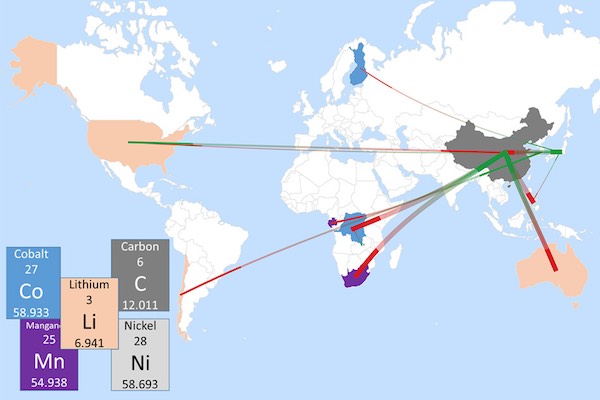
[Image above] Map shows today’s trade flows of key ingredients for lithium-ion battery production, with exports from each country shown in red and imports in green. Credit: Olivetti et al.; MIT
With the rising popularity of lithium-ion battery power—whether for personal electronic devices, energy storage systems, or electric cars—there have been significant concerns swirling over whether supplies of requisite raw battery materials can meet increasing demand.
But according to a new analysis by researchers at MIT, University of California Berkeley, and Rochester Institute of Technology, there should be no major disruptions to battery production, at least in the short term.
The analysis considered the supply of five materials most essential to lithium-ion battery production—lithium, cobalt, manganese, nickel, and graphite—over the next 15 years. The researchers assessed geographical distribution, production facilities, and other variables that affect the materials’ supply.
Of those key materials, not surprisingly, lithium and cobalt account for most of the supply concerns. Lithium resources are plentiful, and at least some methods of production can be quickly increased to meet burgeoning demand.
Cobalt, on the other hand, creates the most anxiety due to its unstable source, the Democratic Republic of Congo, where it’s a major challenge to open new mines to increase supply.
Even with those challenges, however, the researchers conclude that for battery materials over the short-term, “there are potentially some bottlenecks in the supply chain, but no serious obstacles to meeting the rising demand,” according to an MIT news release.
However, that doesn’t mean that there are no supply risks—especially if there is rapid adoption of electric vehicles, which would stress the balance between supply and demand, the authors write in their full perspective article, published in Joule.
So, according to lead researcher Elsa Olivetti, “it’s important for stakeholders to be aware of the bottlenecks,” and, consequently, “know where and when to panic.”
For more information, the open-access article, published in Joule, is “Lithium-ion battery supply chain considerations: Analysis of potential bottlenecks in critical metals” (DOI: 10.1016/j.joule.2017.08.019).
Did you find this article interesting? Subscribe to the Ceramic Tech Today newsletter to continue to read more articles about the latest news in the ceramic and glass industry! Visit this link to get started.
